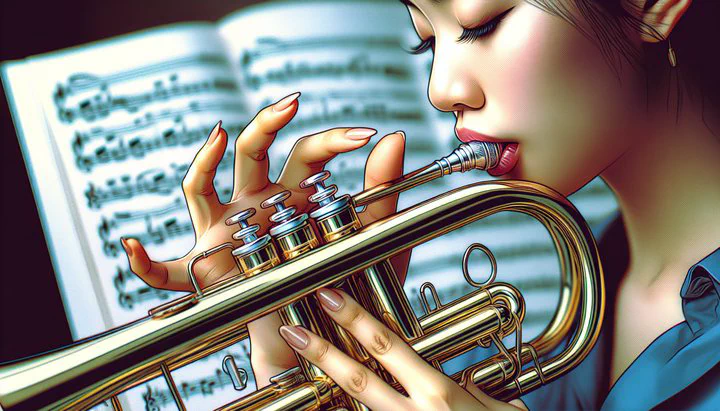Trumpet Embouchure Adjustment Tips

Trumpet Embouchure Adjustment Tips
Are you a trumpet player struggling with embouchure issues? Whether you’re just starting out or have years of experience, refining your embouchure can enhance your sound and ease of playing. This guide will help you overcome common challenges and improve your trumpet embouchure.
Understanding Trumpet Embouchure
When you play the trumpet, embouchure is a big deal. It’s how you use your lips, facial muscles, and even your teeth and jaw to create sound. Imagine trying to whistle—without the right lip shape, it just won’t work. The same goes for your trumpet playing. Your embouchure is the key to making beautiful music and hitting all the right notes.
Many trumpet players, whether beginners or seasoned musicians, face challenges with their embouchure. You might find that your embouchure is not centered, or perhaps you notice an indentation in your upper lip after playing for a while. These problems can make it difficult to play consistently and can even affect the quality of your sound. If you’ve ever thought, “I need some embouchure advice,” you’re not alone.
Having the correct embouchure position and making necessary adjustments is crucial. When your embouchure is well-positioned, it helps you achieve a clear, strong sound and makes playing easier. In the next sections, we’ll explore common embouchure problems and provide practical advice on how to adjust your trumpet embouchure for better performance. Whether you’re struggling with consistent light pressure for low/high notes or simply need tips to improve your playing, we’re here to help guide you on your musical journey.
Common Embouchure Problems and Solutions
Many trumpet players encounter similar challenges with their embouchure. One frequent issue is when the embouchure is not centered. This means your lips might not be aligned properly with the mouthpiece, leading to a sound that doesn’t have the clarity you desire. If you find yourself constantly adjusting to find the sweet spot, don’t worry—this is a common problem. To fix this, try practicing in front of a mirror. This helps you see your lip placement and make necessary adjustments. Over time, you’ll develop a better feel for centering your embouchure, leading to a more consistent sound.
Another concern some players face is finding an indentation in my upper lip after playing for a while. This happens when too much pressure is applied to the lips against the mouthpiece. If you notice this happening, it might be time to take a break and let your lips rest. To prevent this issue, focus on using the muscles around your lips instead of pressing hard. You can practice exercises that strengthen these muscles, which will help reduce the pressure needed to play.
Pressure inconsistencies are another hurdle many players encounter. You might struggle with maintaining consistent light pressure for low/high notes. Applying too much pressure can tire your lips quickly and affect your sound quality. Try practicing long tones at different dynamic levels to help control your pressure. Start with soft notes and gradually increase the volume without changing the pressure on your lips. This exercise can greatly improve your ability to maintain a stable embouchure across all registers.
Listening to experienced players and their embouchure advice can be incredibly helpful. Many seasoned musicians recommend warming up with simple buzzing exercises on the mouthpiece alone. This helps you focus on your embouchure without the added weight of the trumpet. Remember, every player is different, and finding what works best for you might take some time. Keep experimenting with these tips, and soon you’ll find your embouchure becoming more reliable and resilient.
Techniques for Consistent Pressure and Sound
Maintaining consistent light pressure for low/high notes is essential for any trumpet player striving for a balanced and beautiful sound. When you apply too much pressure, your lips can tire quickly, making it harder to play and affecting your sound quality. Finding the right balance helps you play more comfortably and enhances your musical expression. Let’s explore some strategies to achieve this.
One effective technique is practicing long tones. Start by playing a note softly and gradually increase the volume. Focus on keeping the pressure on your lips consistent throughout. This exercise helps you control the pressure and improves your ability to maintain a stable embouchure across different note ranges. Remember, the goal is to produce a clear and steady sound without straining your lips.
Buzzing exercises can also be beneficial. By buzzing on the mouthpiece alone, you can focus entirely on your embouchure without worrying about the trumpet itself. This helps you develop a strong and flexible embouchure, which is crucial for maintaining consistent pressure. Try buzzing simple melodies or scales to challenge yourself and build endurance.
Listening to and learning from experienced players’ embouchure advice can provide valuable insights. Many seasoned musicians emphasize the importance of relaxing your facial muscles while playing. Tension can lead to excessive pressure and fatigue. Practice playing in a relaxed state, and you’ll notice an improvement in your sound quality and stamina.
Finally, always remember to take breaks and give your lips time to rest. Overplaying can lead to fatigue and hinder your progress. By incorporating these techniques into your practice routine, you’ll develop a more stable and resilient embouchure, allowing you to enjoy playing the trumpet with greater ease and confidence.
Remember, every trumpet player is unique, and finding what works best for you is part of the fun. Keep experimenting, stay patient, and your embouchure will improve over time. Join our community of musicians at InstrumentAdvisor to share your journey and learn from others. We’d love to hear about your progress!